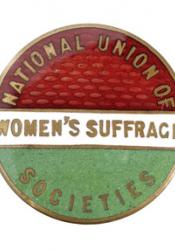Founding of the National Union of Women's Suffrage Societies
On October 16, 1896, approximately twenty leaders of women’s suffrage organizations in Britain gathered together at the Birmingham Conference to discuss the possibility of merging their individual societies into one joint organization. Because each society was fighting for the same overall goal-- women’s suffrage-- they decided that uniting their organizations would be a beneficial and powerful strategy (Hume 4, Vellacott 1). Thus, one year later, on October 14, 1897, the National Union of Women’s Suffrage Societies, commonly acronymized as NUWSS, was founded. At its founding, the NUWSS had seventeen member societies, including many of the largest and most influential women’s suffrage organizations in Britain at the time (Hume 4). The seventeen member societies branded themselves-- and the NUWSS as a whole-- as a non-militant, constitutional, and non-party-affiliated organization united to achieve women’s suffrage (Holton 1, Hume 5, Vellacott 1).
In the early years, the role of the NUWSS was limited. Because each member society still functioned independently in its designated location and the NUWSS had no funds to support its members, the organization had little control over how the individual societies functioned. Instead of managing its members, the main duty of the NUWSS was to communicate with the Committee of Parliamentary Supporters of Women’s Suffrage (Hume 6, Vellacott 2). Direct communication with Members of Parliament was the first step in getting the government to hear and consider the idea of women’s suffrage (Hume 6).
Spearheading the NUWSS after its founding was Millicent Garrett Fawcett who served as the president of the organization from 1898-1919 (Holton 1, Hume 7-8). Fawcett had experience with women’s rights, as she grew up with a father who was a strong believer in feminism and a sister who helped to pave the way for women in the medical field (Holton 1). Fawcett and many other members of NUWSS were described as women whose personalities closely resembled that of a typical Victorian woman. They were kind wives and mothers and gentle, loving figures all around (Hume 13). While this helped create a sense of camaraderie among the societies in the NUWSS, it was not helpful in their quest to have their issues heard or considered by the government.
In general, 1897-1903 were building years for the NUWSS and were not as successful as perhaps the organization had hoped. The NUWSS tried to advocate for their cause, but they were often too gentle and did not fight to break the sex barriers to have their voices heard by Members of Parliament (Hume 9-11). After years of not having a single concern of theirs talked about in the House of Commons, the Committee of Parliamentary Supporters of Women’s Suffrage suggested that the individual member societies of the NUWSS directly approach Members of Parliament who lived in their area to communicate to them the importance of women’s suffrage (14). If Members of Parliament could be convinced women’s suffrage was an important cause, perhaps the entire Parliament would listen to the issue.
In 1903, after the Boer War was over and a General Election was approaching, the NUWSS had a change in strategy. In late 1903, two-hundred women from the NUWSS and other women’s rights societies met for a convention in London (Holton 1, Hume 20-21). What is argued to be the most important aspect of the 1903 convention was the idea that going forward, the NUWSS would establish new committees in every county in Britain and Ireland (Hume 21). These new committees would commit themselves to consistently speaking with Members of Parliament and electoral candidates about the women’s suffrage issue as well as informing the general public about the importance of women’s suffrage and encouraging them to only support candidates who supported the cause (Hume 21, Vellacott 2). These actions helped to establish the NUWSS as a united, governing body rather than a collection of individual societies (Hume 21-22).
After the 1906 election where the Liberal party secured its place in office, the NUWSS was hopeful that its campaigning efforts would lead the House of Commons to discuss women’s suffrage, but they were, once again, overly optimistic (Hume 23). After having no success in having their concerns heard, in July 1906, the NUWSS started a movement to speak to individuals in Parliament who were against women’s suffrage to try to convince them to rethink their position. Then, in October of the same year, the NUWSS announced it would sponsor a candidate who supported women’s suffrage (26).
While all of these efforts were steps in the right direction in the overall goal of achieving women’s suffrage, the NUWSS was still a fairly new and growing society. In the following years, the organization had its share of ups and downs. It organized public events to further campaign for this cause, and it was eventually renamed the National Union of Societies for Equal Citizenship (Holton 4). The fight for equal voting rights for women continued into 1928 when it was finally achieved thanks, in part, to the work of the National Union of Women’s Suffrage Societies.
Works Cited
Holton, Sandra Stanley. “National Union of Women's Suffrage Societies (Act. 1896–1918).” Oxford Dictionary of National Biography, 24 May 2008, doi:10.1093/ref:odnb/96378.
Hume, Leslie Parker. The National Union of Women's Suffrage Societies 1897-1914. Vol. 3, Routledge, 2016.
Vellacott, Jo. Pacifists, Patriots and the Vote: The Erosion of Democratic Suffragism in Britain During the First World War. Palgrave Macmillan, 2014.

